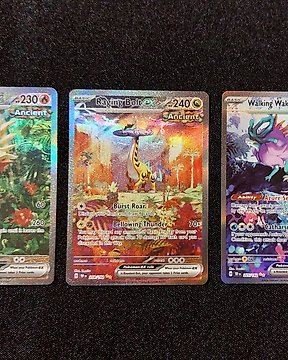
Pokémon - 3 Card - Pokemon Temporal Forces TEF 204 Gouging Fire EX, TEF 205 Walking Wake EX and TEF 208 Raging Bolt EX
N.º 83491219

N.º 83491219

Man votive offering.
Iberian
4th -2nd century BC
Bronze
Height 5,2 cm 9,4 cm as mounted.
PROVENANCE:Private collection, Windsor, Conneticut (USA). Before in a collection fo Mr. Lewis, New York, 1991. Acquired to Atlantis Antiquities, New York, 3rd May 1991.
DOCUMENTS: Including export license from the Ministry of Culture in Spain.
CONDITION: Good condition, intact.
DESCRIPTION:
Iberian bronze round bronze votive tablet depicting a male figure in a standing position, with his legs together and his arms folded over his chest, without his elbows protruding from his profile due to the extreme synthesis of his design. The man wears a tunic with a belt and a hemispherical helmet with a wig cover, indicating that he was probably a warrior. The face is synthetic, with small eyes worked with circular incisions, a straight nose and a half-open mouth.
In the National Archaeological Museum there are several votive offerings with this same type of male figure standing, dressed, with his arms outstretched on either side of his body or in a similar position, as is the case with two examples from the collection of Carlos Walter Heiss (figs. 1 and 2).
The name Iberian refers to the human groups that inhabited the Mediterranean and southern areas of the Iberian Peninsula between the 4th century BC and the Romanisation of the area, until the 1st century BC. The Iberian culture therefore extended over a wide area stretching from Andalusia to Languedoc in southern France. It was a creative, advanced civilisation, sustained by a society organised around fortified hilltop cities, strongly hierarchical and linked by trade with the Greeks and Phoenicians.
The Iberians developed their own art, with a marked personality and, at the same time, permeable to Eastern influences, especially those of classical and Hellenistic Greece. Indissolubly linked to religion, Iberian art is related to funerary beliefs and the development of sanctuaries, which had a dual function as a sacred place and as a border marker. The interpretation of the works of art found in Iberian necropolises and sanctuaries allows us to learn about the beliefs of this people, their legends and even the personal religiosity of individuals.
Particularly noteworthy are the votive offerings, one of the most characteristic manifestations of Iberian culture, generally made in lost-wax bronze, although they have also been preserved in stone and terracotta. These are small statuettes, around 10 cm in height (the largest are no more than 25 cm), commissioned by high-ranking figures to be offered in the sanctuaries in exchange for protection, well-being, health or prosperity. In fact, most of them have been found in the cave sanctuaries of Despeñaperros, Sierra Morena and Castellar, in Jaén, as well as in La Luz, Murcia. Although they are a very heterogeneous group, they are generally stylised images of men or women in a reverential attitude, with exaggerated features or sexual organs (in the case of those related to fertility), although there are also known votive offerings representing horsemen, horses and other animals and also parts of the body, the latter related to the healing of illnesses or specific limbs.
BIBLIOGRAPHY:
- ARANEGUI GASCÓ, C. Los íberos ayer y hoy. Arqueologías y culturas. Marcial Pons Historia. 2017.
- BERMEJO TRIADO, J. Breve historia de los íberos. Nowtilus. 2010.
- PRADOS TORREIRA, L. Exvotos ibéricos de bronce del Museo Arqueológico Nacional. Ministerio de Cultura. 1992.
- QUESADA SANZ, F. “Los íberos y la cultura ibérica”, en CELESTINO PÉREZ, S., coord., La protohistoria en la Península Ibérica. Akal. 2017.
- RUEDA GALÁN, C.; HERRANZ SÁNCHEZ, A.B.; BELLÓN RUIZ, J.P., coord. Exvotos íberos. Paisajes sagrados, peregrinaciones y ritos. Universidad de Jaén. 2021.
- RUIZ, A.; MOLINOS, M. Los íberos. Análisis arqueológico de un proceso histórico. Grijalbo. 1993.
- TARRADELL, M. Arte ibérico. Polígrafa. 1968.
- VV.AA. Revista de Estudios Ibéricos. Universidad Autónoma de Madrid. 1994-1998.
PARALLELS:
Fig. 1 Male ex-voto. Spain, 4th-1st century BC. Bronze. National Archaeological Museum, Madrid, inv. 1942/100/16.
Fig. 2 Male ex-voto. Spain, 4th-1st century BC. Bronze. National Archaeological Museum, Madrid, inv. 1942/100/17.
Notes:
- The piece includes authenticity certificate.
- The piece includes Spanish Export License.
- The seller guarantees that he acquired this piece according to all national and international laws related to the ownership of cultural property. Provenance statement seen by Catawiki.
THE MINISTRY OF CULTURE FROM SPAIN ASKS ALL SELLERS FOR INVOICES OR OTHER DOCUMENTATION ABLE TO PROVE THE LEGALITY OF EACH ITEM BEFORE PROVIDING AN IMPORT OR EXPORT LICENSE.
Como comprar na Catawiki
1. Descubra algo especial
2. Faça a licitação vencedora
3. Faça um pagamento seguro